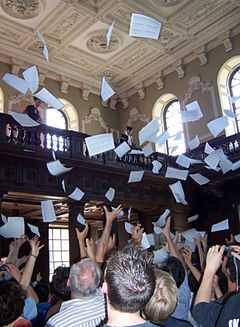Part III of the Mathematical Tripos

Part III of the Mathematical Tripos (officially Master of Mathematics/Master of Advanced Study) is a one year Masters-level taught course in mathematics offered at the Faculty of Mathematics, University of Cambridge currently taken by over 200 students each year. Roughly one third of the students take the course as a fourth year of mathematical study at Cambridge, whilst the remaining two thirds take the course as a one year course.[1]
History
The Smith's Prize Examination was founded by bequest of Robert Smith upon his death in 1768 to encourage the study of more advanced mathematics than that found in the undergraduate course. T. W. Körner notes
Only a small handful of students took the Smith's prize examination in the nineteenth century. When Karl Pearson took the examination in 1879, the examiners were Stokes, Maxwell, Cayley, and Todhunter and the examinees went on each occasion to the examiner's house, did a morning paper, had lunch there, and continued their work on the paper in the afternoon.
In 1883 this was replaced by an exam called Part III and the Smith's Prize awarded for an essay rather than examination. In 1886 this exam was renamed Part II, and later in 1909 Part II, Schedule B. In 1934 it was again renamed Part III.[1] In the 1980s the Certificate of Advanced Study in Mathematics was introduced, and in 2010 CASM was replaced by two new degrees, the Master of Mathematics and Master of Advanced Study.
Students who have completed their undergraduate degrees at Cambridge will be awarded the Master of Mathematics (M.Math.) degree for four years of study. Students who complete Part III of the Mathematical Tripos, but did not complete undergraduate studies at Cambridge will be awarded the Master of Advanced Study (M.A.St.) in Mathematics degree for the one year course.[2][3] This will allow Cambridge graduates to remain eligible for government funding for the course. All those who have taken the course since 1962 have the right to proceed to these new degree titles.[1] The first retrospective M.Math and M.A.St. degrees were conferred in October 2010.[4] The course is often still referred to as Part III.
Current course structure
The course lasts one year, divided into three eight-week terms. There are a wide variety of lectures on both pure and applied maths, mostly concentrated in the first two terms. The third term is primarily for examinations (and revision for said examinations) which, together with the option of writing a part III essay (introduced in the 1970s, a miniature thesis of sorts, often in the form of a literature review), determine one's final grade entirely.
Grading
The grades available are Fail, Pass, Merit, and Distinction (the Merit grade was introduced in 2000). The level of achievement required for a merit is equivalent to a First Class in the other parts of the Tripos,[5] and that required for the distinction yet higher.
Prizes
In addition to the grades, there are five associated prizes. Four of these may be awarded at the discretion of the examiners: the Mayhew Prize for Applied Mathematics, the Tyson Medal for mathematics and astronomy, the Bartlett Prize for applied probability[6] and the Wishart Prize for statistics.[7] Several notable astronomers and astrophysicists have been awarded the Tyson Medal in the history of Part III maths, including Jayant Narlikar, Ray Lyttleton and Edmund Whittaker. In addition, the Thomas Bond Sprague Prize is awarded by the Rollo Davidson Trust for distinguished performance in actuarial science, finance, insurance, mathematics of operational research, probability, risk and statistics.
References
- Faculty of Mathematics, University of Cambridge, Certificate of Advanced Study in Mathematics (Part III of the Mathematical Tripos), last updated 28 May 2007.
- ↑ 1.0 1.1 1.2 1.3 "Discussion on the establishment of a degree of Master of Mathematics and a degree of Master of Advanced Study". Cambridge University Reporter. 2009-01-28. Retrieved 2009-04-30.
- ↑ "Joint Report of the Council and the General Board on the establishment of a degree of Master of Mathematics and a degree of Master of Advanced Study". Cambridge University Reporter. 2008-12-10. Retrieved 2009-04-30.
- ↑ "Graces submitted to the Regent House on 11 March 2009". Cambridge University Reporter. 2009-03-11. Retrieved 2009-04-30.
- ↑ T. W. Körner. "Award of the Master of Mathematics and the Master of Advanced Study in Mathematics". Retrieved 3 December 2010.
- ↑ http://www.maths.cam.ac.uk/postgrad/mathiii/creditdetails.html
- ↑ https://www.admin.cam.ac.uk/univ/so/2013/chapter12-section2.html#heading2-28
- ↑ https://www.admin.cam.ac.uk/univ/so/2013/chapter12-section2.html#heading2-601